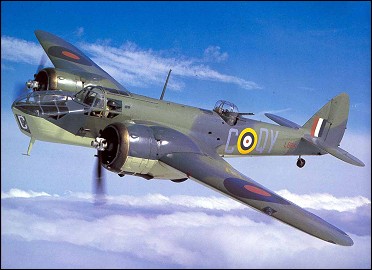|
| The often told story of the six-seat executive aircraft built for Lord Rothermere, proprietor of the aviation-supporting Daily Mail, usually misses the vital point. Why did he want a fast executive aircraft? Primarily it was to show the world that Britain could build a civil aircraft at least as good as the Douglas DC-1. Bristol's Type 142 first flew on 12 April 1935. When tested at Martlesham Heath in June it proved to be 80 km/h faster than Britain's latest fighter prototype.
The outcome was the Bristol Type 142M, the most important changes being to provide armament, a bomb aimer's position, internal bomb stowage and more powerful 626kW Mercury VIII radial engines. To make room for a bomb bay in the lower fuselage, the low-wing configuration of the civil Type 142 was changed to mid-wing for the military version, which became named Blenheim. The prototype made its first flight on 25 June 1936, and initial deliveries went to No 114 Bomber Squadron in March 1937.
The requirement for longer range led to evolution of the long-nosed, increased tankage and strengthened landing gear version, named originally Bolingbroke I. These began to enter RAF service in March 1939, by then designated Blenheim IV.
By the outbreak of World War II Blenheim Is had been superseded by Mk IVs in the UK, but remained in first-line service in Greece and the Western Desert. Blenheim IF night-fighters had their armament of two machine-guns supplemented by a four-Browning under-fuselage gun pack. It was these aircraft which pioneered British airborne radar, serving throughout the blitz of 1940-41. Blenheim IVs had their share of early fame - making the first reconnaissance over Germany of World War II on 3 September 1939, the first attack on the German Fleet on 4 September - and were continuously active over Europe on daylight raids until late 1941.
On 24 February 1941 a modified Blenheim, known originally as the Bisley, made its first flight. Powered by two 708kW Mercury 30 engines, it featured an extensively modified nose and other changes. As the Blenheim V, a total of 940 production aircraft were eventually built in several variants. Although not popular with its crews it remained operational in the Far East until the latter part of 1943.

| MODEL | Bristol "Blenheim Mk IV" |
| CREW | 3 |
| ENGINE | 2 x Bristol Mercury XV, 675kW |
| WEIGHTS |
| Take-off weight | 6532 kg | 14401 lb |
| Empty weight | 4441 kg | 9791 lb |
| DIMENSIONS |
| Wingspan | 17.17 m | 56 ft 4 in |
| Length | 12.98 m | 43 ft 7 in |
| Height | 3.0 m | 10 ft 10 in |
| Wing area | 43.57 m2 | 468.98 sq ft |
| PERFORMANCE |
| Max. speed | 428 km/h | 266 mph |
| Cruise speed | 319 km/h | 198 mph |
| Ceiling | 8310 m | 27250 ft |
| Range | 2350 km | 1460 miles |
| ARMAMENT | 5 x 7.7mm machine-guns, 600kg of bombs |
 | A three-view drawing (897 x 1267) |
| John Richardson, e-mail, 20.04.2013 10:25 Was 29609 one of this type? reply | | My word, 21.03.2011 23:25 Ember is mistaken.
The forward compartment, with scalloped glazing, was occupied solely by one man: the Observer (the navigator and bomb-aimer). His table was always on the Port side, while the high part of the canopy was always on the Starboard. Reason: The pilot seat and controls invariable on the Port (left side looking fwd).
Presumably Ember is getting confused by the rear-firing nose cupola - for which the Wireless Operator /Air Gunner might have to come forward from his position in the turret, aft of the mainplane.
Aside: The three-view is a Mark V reply | | Barry, 11.01.2011 18:17 The Mk V was heavy and underpowered, having originally been designed as a two seat attack aircraft to be known as the Bisley before becoming the 3 seat Blenheim V.
The original Blenheim gained much interest from foreign goverments and export orders were received from Finland, Turkey, Yugoslavia, Greece, Lithuania, Rumania and layer Portugal (illustrated above) reply | | Bjorn Are Stolen, e-mail, 05.05.2010 10:52 A Blenheim IV(?) crashlanded in a bay only 100m from where I live (in Norway), and allthough most of it was removed, one of it's engines still lays on the shore, and I've found part of one part of the landing-gear when I was scubadiving. The family often visits it reply | |
| | Ron Sumner, e-mail, 27.12.2008 12:30 I have been researching my family history to find my surmame has come up with a flight sargent based operating from an airfield in west lancs.,was to be killed in a Bristol blenhiem bomber..,i am a flying r /c model aircraft builder,finishing a prototype developing my own ideas to install these into its design...Looking for paper quarter scale buiding plans of the blenhiem enabling my next project to take place..,it was far ahead of its time,plus adapted well to serve in many parts of the globe,no aircraftcould catch it for sheer speed in its time,although flaps and landing gear levers could,plus caused a real problem for the pilot being next to each other,yes it should have the same fame as the Spitfire as a first class fighter... reply | | EMBER, e-mail, 18.12.2007 03:44 THESE HAD THEIR NOSES SCALOPED TO PROVIDE A BETTER VIEW FOR THE PILOT. IN THIS SCALOPED SIDE (OFTEN THE RIGHT SIDE) WAS A RADIO & THE TWO OPERATORS, ONE OF THEM ALSO BEING THE BOMBADIER. reply |
|
Do you have any comments?
|
| 
COMPANY
PROFILE
All the World's Rotorcraft
|








